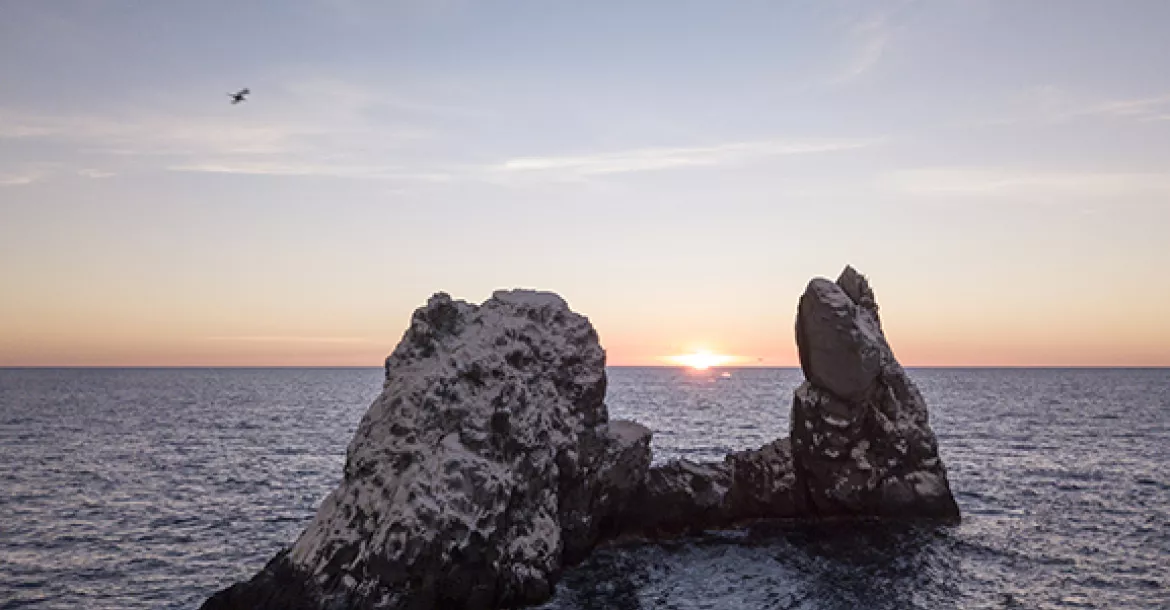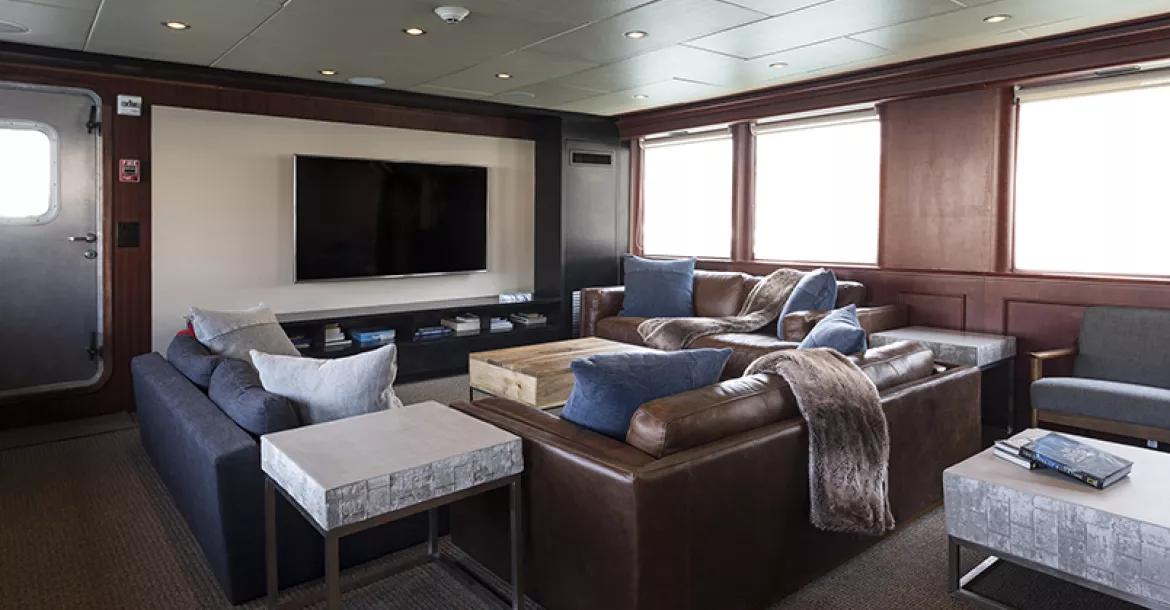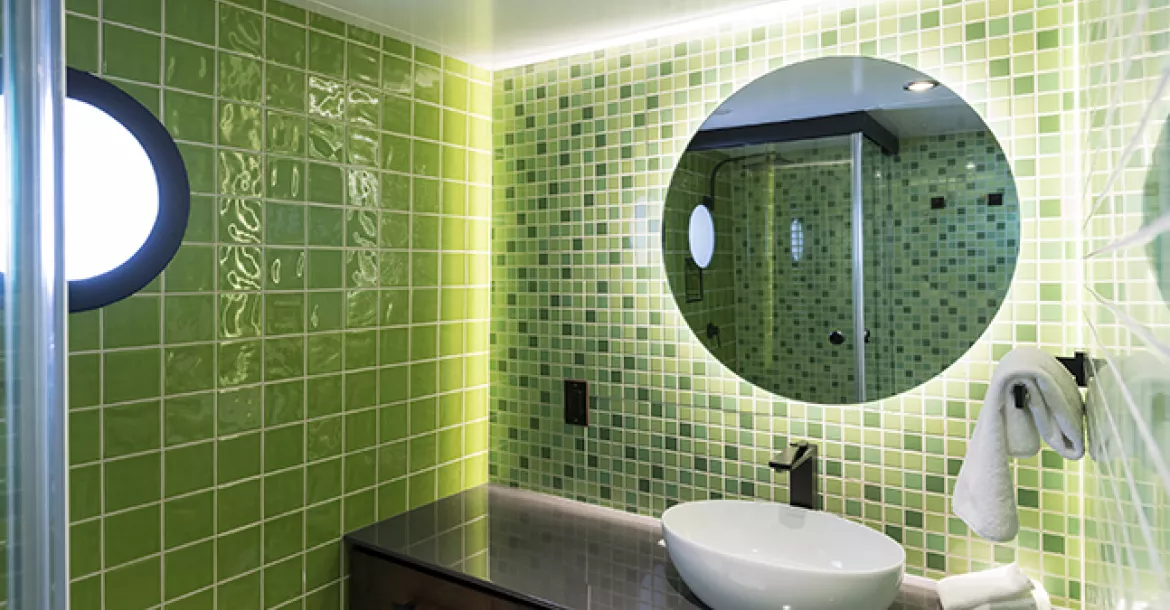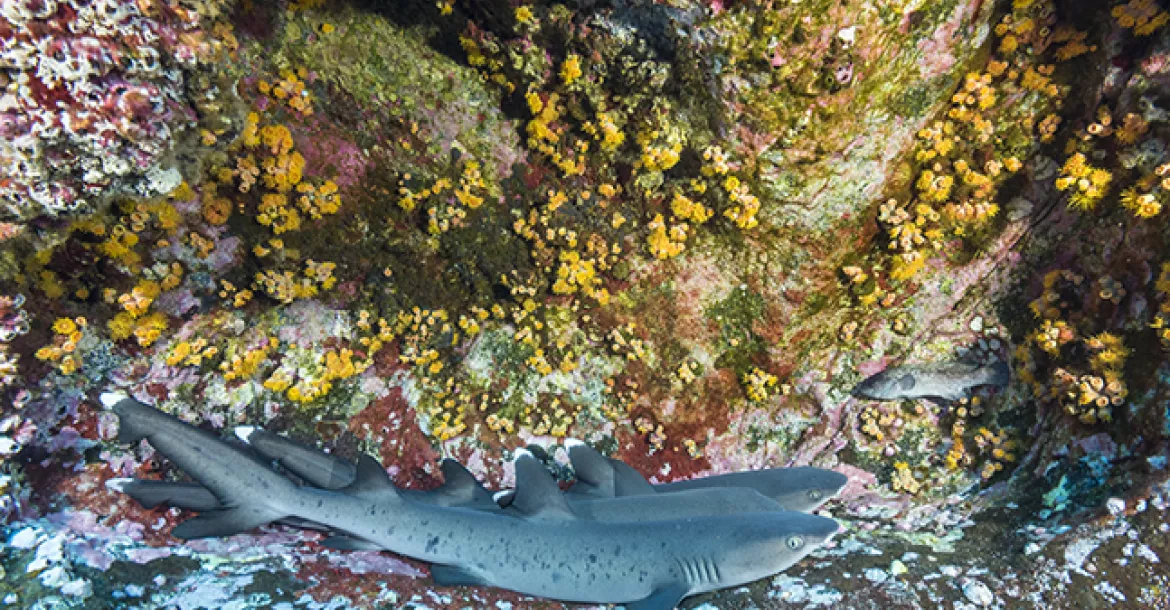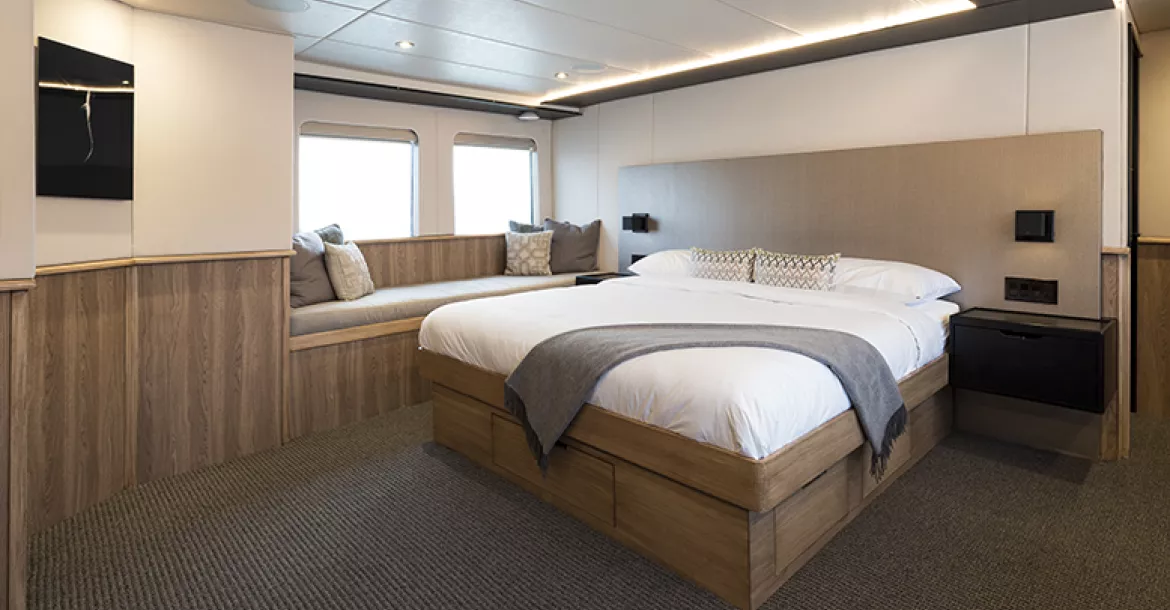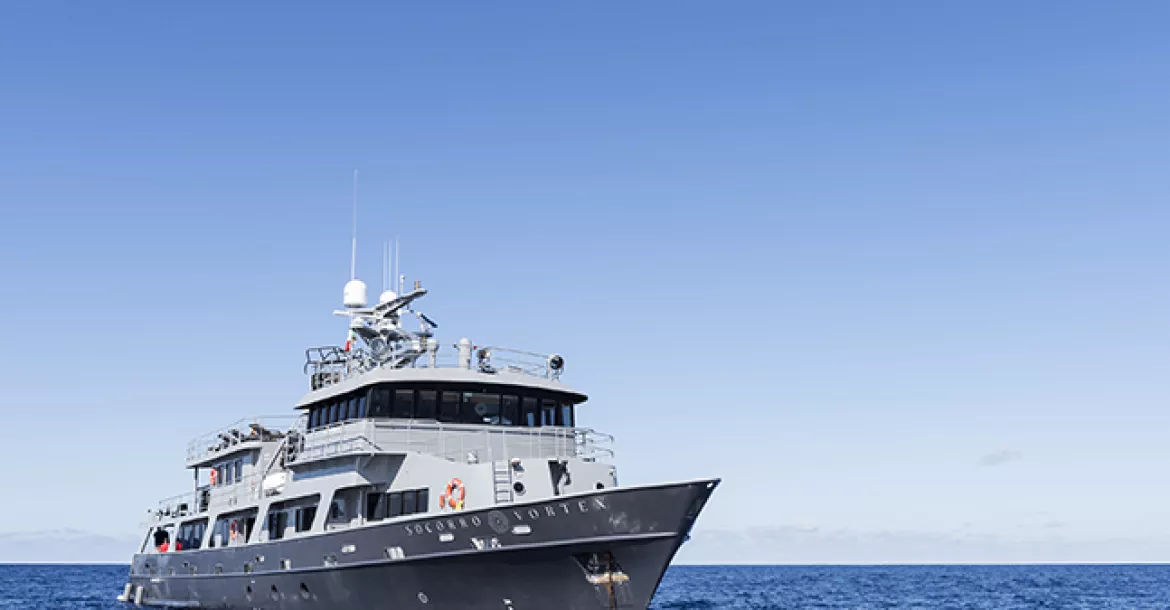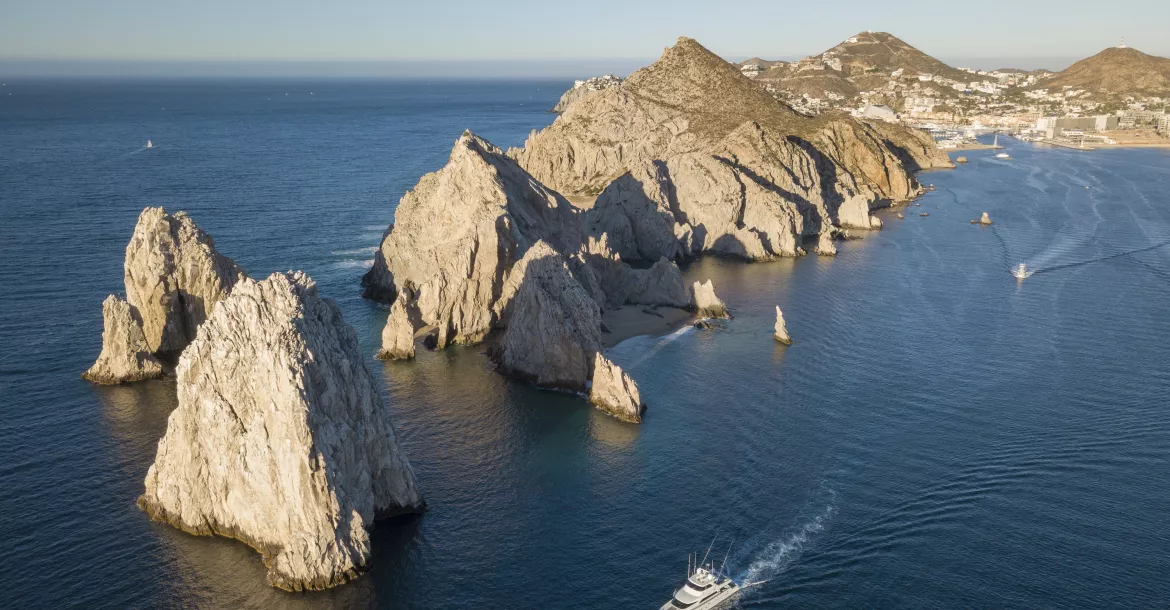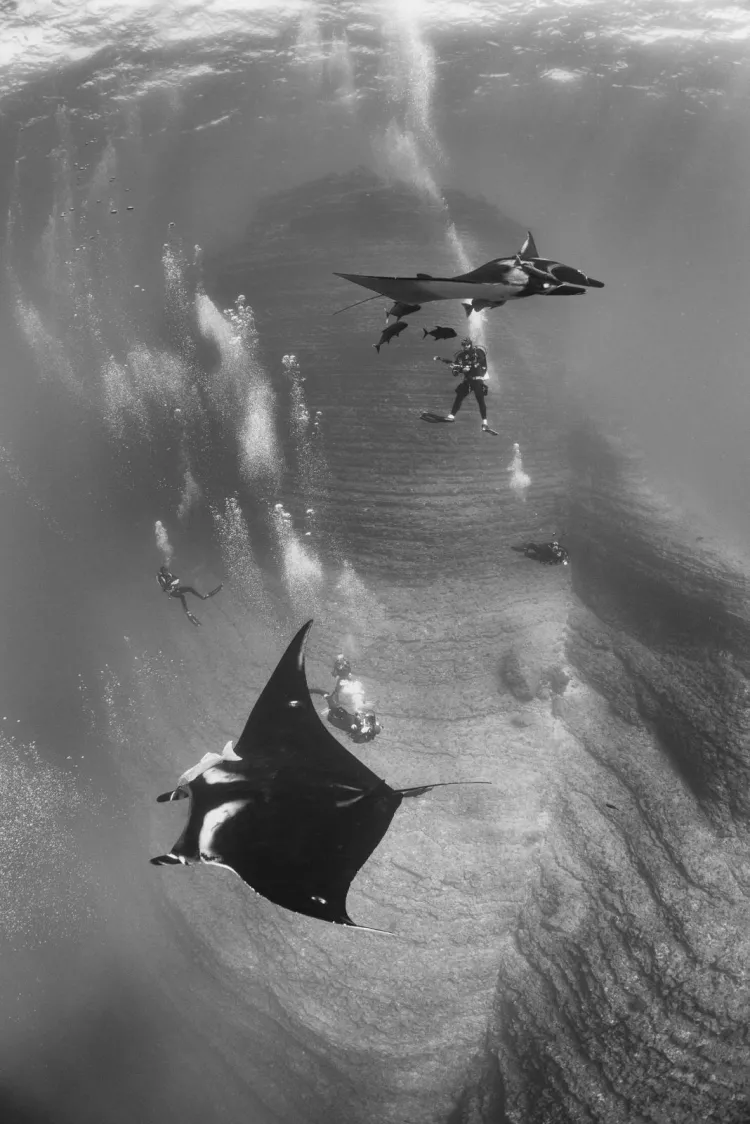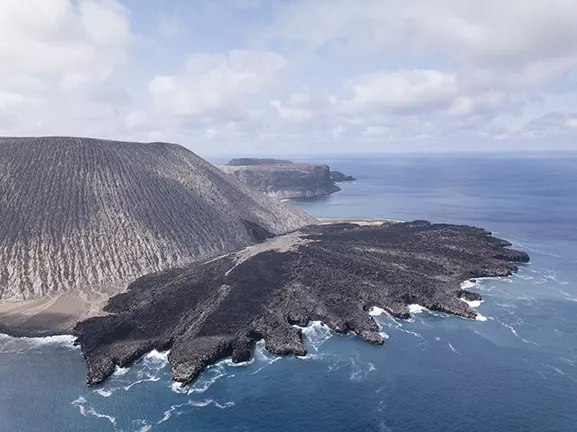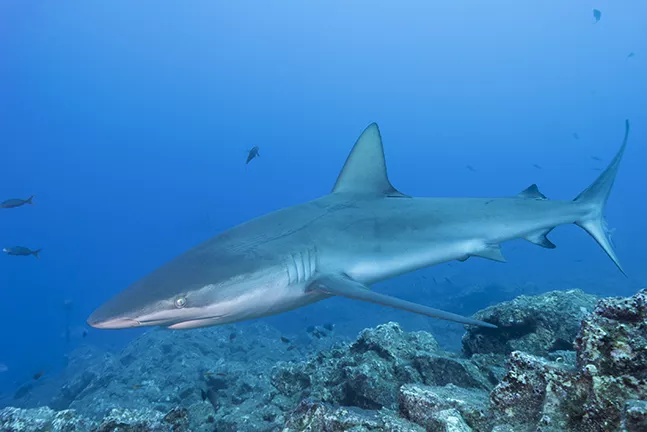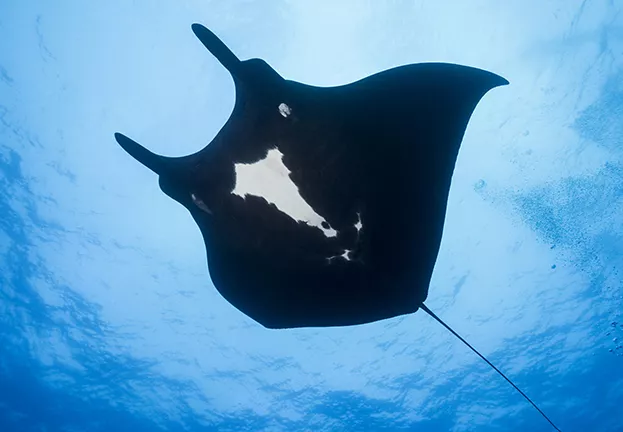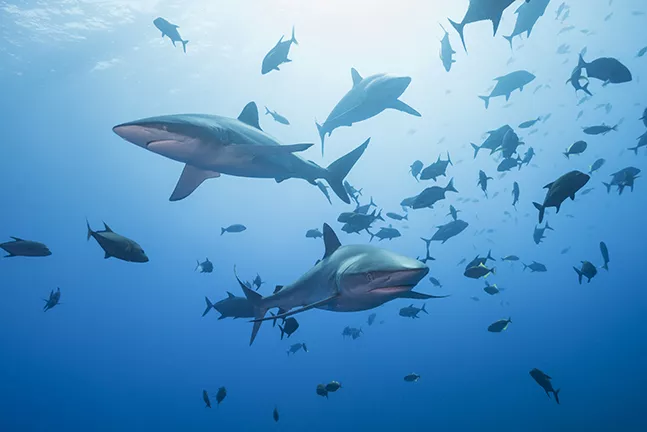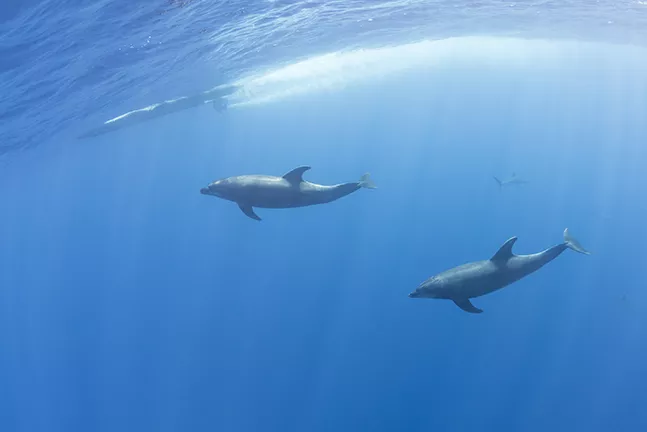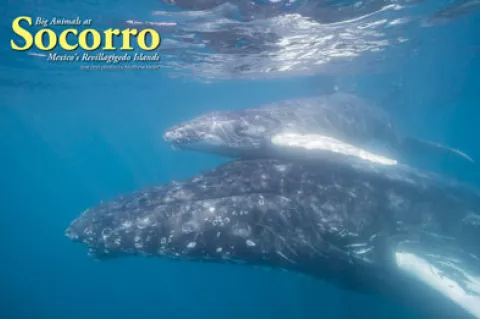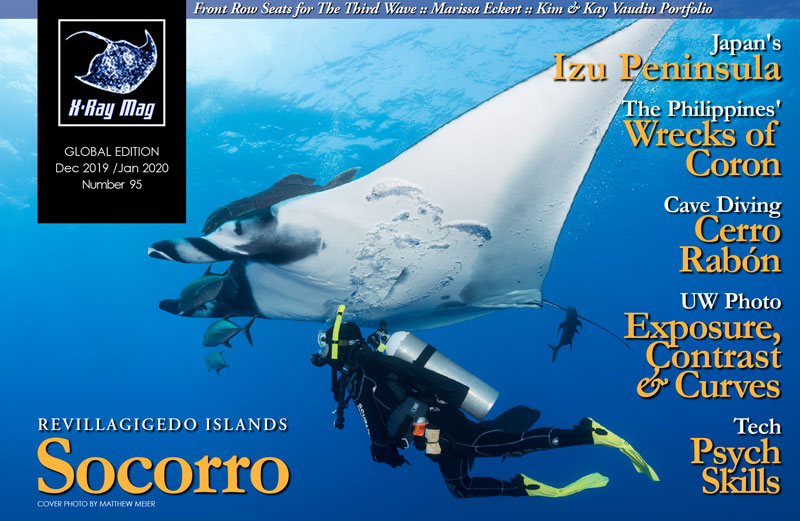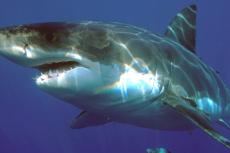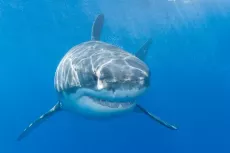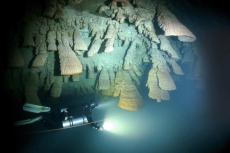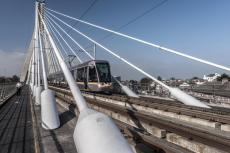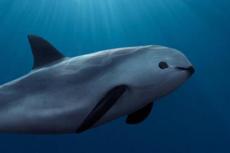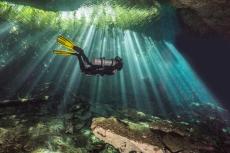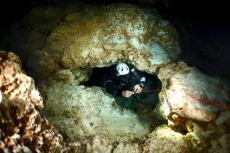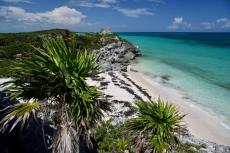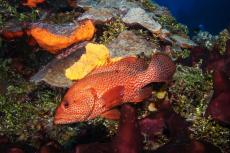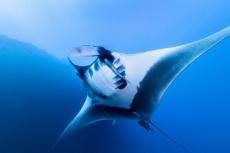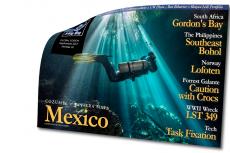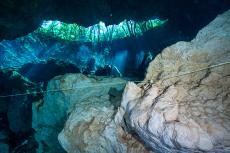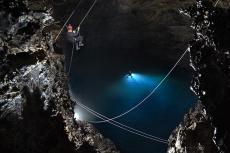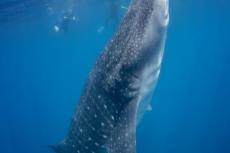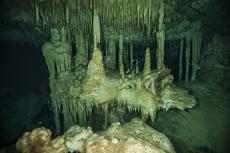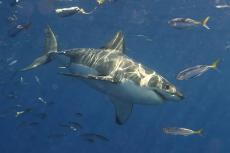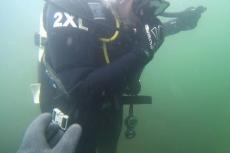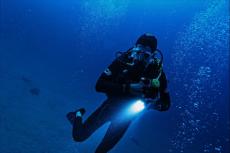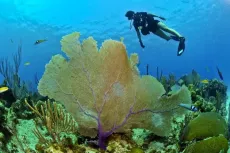Go, go, go! At our skiff driver’s urging, we slipped into the water as quickly and quietly as possible, in hopes of snorkeling with the pod of false killer whales that was hunting in the bay. Again and again, we attempted to intersect their path, but our timing or positioning resulted in views of them in the fleeting distance or not at all. Finally, I was fortunate to have a member of the pod swim past just close enough to capture a few photos with my fisheye lens. At the end of our exhausting excursion, everyone on the dive boat had seen the false killer whales and a few lucky guests had the privilege of swimming alongside a mother and her newborn.
Contributed by
Factfile
Matthew Meier is a professional underwater photographer and travel writer based in San Diego, California.
To see more of his work and to order photo prints, please visit: matthewmeierphoto.com.
This was definitely one of the more exhilarating surface intervals I have ever experienced and an incredible bonus animal sighting on top of all of the manta rays, sharks, dolphins and huge schools of fish we had already encountered while diving. Welcome to big-animal paradise!
The Revillagigedo Archipelago comprises four volcanic islands named San Benedicto, Clarion, Roca Partida and Socorro, which are situated southwest of Cabo San Lucas, Mexico, in the Pacific Ocean. The latter also lends its namesake to the more commonly referred-to Socorro Islands, for those of us who struggle to pronounce “Revillagigedo.” With the exception of a Mexican Navy installation on Socorro, which houses roughly 250 military personnel and their families, the islands are uninhabited.
A liveaboard dive boat is the only way to see this vast frontier due to the islands’ isolated nature. Clarion is the most remote and as such is rarely visited, located 125 miles (200km) past the next farthest island of Roca Partida. San Benedicto and Socorro Islands are close to one another and located roughly 240 miles (386km) from Cabo San Lucas.
The area is famous with scuba divers for the giant oceanic manta rays and other large pelagics that frequent the waters. The Revillagigedo Islands were pronounced a UNESCO World Heritage Site in July 2016, and the Mexican government created North America’s largest marine protected area and also declared it a national park in 2017. The 57,000 sq mi (150,000 sq km) of protected area bans fishing, mining and tourism development within and on the islands themselves.
Manta rays
Giant oceanic manta rays have a wingspan of up to 23ft (7m), and those around the Socorro Islands are some of the largest I have ever seen. They exhibit two different color variations; the black manta is nearly all black on both sides and the chevron manta has a patterned mix of black, white and gray on top and mostly white underneath.
Each individual has distinct spots on their underside and like a human’s fingerprints, the markings can be used for identification. Regardless of their coloration, the mantas around Socorro seem to enjoy diver’s exhaust bubbles on their bellies and will hover in the water column over each diver in turn, giving guests the privilege of experiencing a “manta sombrero.”
San Benedicto Island
San Benedicto Island is closest in proximity to Cabo San Lucas and is typically the first anchorage after an overnight crossing. We arrived in time for a late afternoon checkout dive at Las Cuevas to knock off the rust and perform buoyancy and gear checks.
Situated in a protected cove on the leeward side of the island, the site made for an easy first dive, swimming amongst large boulders and caverns as we searched for lobsters, white-tipped reef sharks, baby porcupine fish and stingrays buried in the sand. We saw several Socorro chub swimming amongst the rocks, most of which are a lackluster gray in color, but the remaining ten to 15 percent of the population scream for attention with a vibrant yellow.
El Canon. The next morning, we dove at El Canon, located near the anchorage on the backside of the island. The underwater topography consisted of a horseshoe-shaped, downward sloping rock structure, separated by a sand flat. Sitting at 90ft, the main attraction is a cleaning station above a rocky pinnacle near the drop-off to deep water. Here, you can duck behind the rocks and observe Galapagos and silvertip sharks swimming circular patterns around the formation while you wait for manta rays to arrive.
We had at least one manta show up on every dive and were treated to hunting Pacific bottlenose dolphins chasing jacks in the dim early morning light of our first dive. It was here that I also saw my first black manta ray.
I have swum with chevron and reef manta rays on various dives across the globe but had never been graced by the presence of a black manta ray. This beautiful creature snuck up on us as we were working our way down the rocky reef to the cleaning station. One minute, I was seemingly alone with my thoughts, and the next, I had a massive shadow gliding off my left shoulder. The camera came up out of reflex, and I did my best to stay close. But keeping up with a manta ray without the aid of external propulsion is pure fantasy and it easily disappeared into the distance. Happily, we were able to see several more black manta rays over the course of our trip, and I had numerous opportunities to improve on my first photo attempts.
Returning to the boat after each dive, we witnessed several silky sharks near the surface and discovered hundreds of fish hiding below, using the overhead structure as a refuge. There were several schools of jacks of differing species, all staying in close-knit groups for protection against the silky sharks, who were keen for a meal but equally curious to inspect the divers in their midst as well.
Volcanic origins
The distinct cinder cone shape of San Benedicto Island was created from a supposedly dormant volcano that last erupted in 1952. On the eastern side of the cinder cone, a massive lava flow exploded out of its base, creating new land as it spread out into the ocean. The black lava rock stands out in sharp contrast to the ash-colored cone and is an impressive sight. However, to reveal the truly remarkable scope of the lava flow, the elevated perspective of a drone is required. I captured several multi-stitch panoramic shots of the island and was as excited about those aerial photos as I was with any of the spectacular underwater wildlife shots.
At the southern end of the anchorage is a rock structure known as the Sleeping Lady, which is formed by the outline of the island. She was pointed out to me while in silhouette at sunset, and since then, I have been unable to gaze at the scene without seeing a lady in repose.
Boiler. On our second full day of diving, we transferred to the world-famous Boiler dive site on the other side of San Benedicto. This enormous underwater rock pinnacle reaches nearly to the surface depending on the tides and drops off sharply into the inky darkness below.
Large schools of fish use the rock as a safe haven against predators and are often found at the northern or southern ends depending on the current. We saw aggregations of bigeye jacks, blackjacks, bluefin trevally, razor surgeonfish and Pacific creolefish. White-tipped reef sharks rest on rock ledges during the day, conserving energy to pack hunt at night, often with huge blue spiny lobster standing guard nearby.
The real stars however are the large pelagic critters that can show up at any time. Manta rays are a near constant inhabitant, and the Pacific bottlenose dolphins here can be very friendly, often stalling in front of a diver as if asking for a belly rub. Several dolphins swam by on our first dive but kept their distance since they were escorting a new baby.
Whale sharks have been known to materialize out of the blue, and in the springtime, humpback whales frequent the area, though it is rare to actually see them in the water here. More often, you can hear and sometimes feel their calls resonate through the water, as they stay just far enough away to tempt you to chase their vocalizations into the void.
I did just that on my first trip to Socorro, spending an entire dive swimming into the blue, chasing the sound of the singing whales but never saw a thing. This is also where we spent one of our surface intervals in search of the false killer whales. The pod was hunting around the island for several weeks, and we had interactions with them on two separate days.
The liveaboad
The latest liveaboard to operate in the Revillagigedo Islands is the luxurious new Socorro Vortex. She is a former Canadian Coast Guard vessel that has been completely redesigned with seven spacious staterooms, extensive lounge areas, expansive camera tables and a hot tub on the top sun deck.
Each guest room has an en suite bath, individual air conditioning, unique artwork, abundant storage and either two twin beds or a king-size bed. The unique tile design and color scheme of each bathroom is also an elegant and fun touch. At 140ft (43m) in length and with a top speed of 18 to 20 knots, she is capable of making the transits between islands faster than any other liveaboard in action. The Vortex is an exclusive treat for her max of only 14 guests.
Diving
Diving at the Socorro Islands is meant for advanced divers with reliable buoyancy control, who are comfortable in blue water and an often bottomless environment. When sea conditions allow, divers may make a giant stride directly down to the dive site, but more frequently they are transported from their anchored liveaboard by an inflatable RHIB called a panga, before back-rolling into the water.
A normal day consists of three to four dives, depending on location, each of which is limited by Mexican regulations to 45 minutes in length. Night dives are not permitted. Dive guides are responsible for three to five divers each, and everyone is required to carry a surface marker, whistle and GPS positioning device in case they get lost from the group and drift out to sea. For an added level of safety, the Socorro Vortex is a nitrox-only boat, and we dived with a mixture of 30 to 32 percent, depending on the depth of the dive site. Every tank was filled and analyzed by the crew, before being confirmed by each diver prior to a dive.
Socorro Island
Every trip to the Revillagigedo Islands requires a stop at Socorro Island, a short 30-mile (48km) passage from San Benedicto, to register with the Mexican Navy and verify passports. This is typically done in the late afternoon—in our case, following three dives at the Cabo Pearce dive site.
Located at the end of a long lava flow peninsula extending out into the ocean, the area comprises large boulders, valleys and channels—as one might expect from boiling lava exploding into the cool water. The peninsula climbs several stories above the water’s surface, with sheer walls and a small cave spanning the entire width near its base at the water’s edge.
Dozens of brown booby birds roost on the small ledges along the volcanic walls, providing sanctuary from potential predators and easy access to the prolific feeding grounds in the waters below. Cemented on a rock ledge, around 40ft underwater, is a plaque commemorating the area’s UNESCO World Heritage Site status: “inscribed for its outstanding universal value which deserve protection for the benefit of all humanity.” A large green sea turtle nearly guided us to the plaque on our first dive before continuing on its path as we stopped to take photos.
From there, we moved across the rocky terrain to a submerged buoy that marked a cleaning station for mantas and other pelagic visitors. Dozens of yellow barberfish congregated around the rocky outcropping, waiting for an easy meal. After lingering unsuccessfully to see the cleaners in action, we drifted with the current into blue water and found a large school of striped bonito being chased by silky and silvertip sharks, along with several small yellowfin tuna. A few dozen scalloped hammerhead sharks were also gathering in the hazy distance, but attempts to capture images in the murky visibility were futile.
After our dives, while anchored in the harbor of the navy base awaiting our inspection, we were treated to mating loggerhead turtles at the water’s surface. The action went on for well over an hour before abruptly ending near sunset with a loud splash, as the turtles dived underwater, not to be seen again.
Roca Partida
Departing the navy base, we motored for roughly 7.5 hours overnight to Roca Partida. This north-south-oriented, field-goal-shaped seamount, whose name literally translates to “split rock,” rises 100ft (30m) above sea level and measures only 300ft (90m) long by 26ft (8m) wide. It is the lone sliver of land for nearly a hundred miles in any direction. As such, it attracts a spectacular variety of life. Massive schools of cottonmouth jacks, bigeye jacks, blackjacks, striped bonito, yellowfin tuna and Pacific creolefish were present on nearly every dive. As were the Galapagos, silky and occasional scalloped hammerhead sharks, which were pursuing the fish around the rock.
We saw a few manta rays as well, but nothing compared to the numbers we encountered at San Benedicto. Whitetipped reef sharks lay on top of one another, consistently stacked onto ledges 40-50ft (12-15m) down, along with the biggest blue spiny lobsters I had ever faced. Immense wahoo circled during safety stops, along with the curious silky sharks, which seemed keen to sneak up on divers from behind.
Though we were not lucky enough to see them on our trip, tiger sharks have made appearances here, as have whale sharks, orca, large bait balls and schools of Galapagos and hammerhead sharks. In the springtime, typically during the months of February and March, a mother humpback whale and her calf have been seen here in years past. The divemasters speculate that the mother may have been introduced to divers at Roca with her mother and is comfortable bringing her offspring back to this location.
Due to the potential for deep dives and the extreme remoteness of Roca Partida, the Mexican government limits operators to three dives per day. We were blessed with relatively calm seas during our visit and anchored overnight, affording us two full days of diving.
On our second morning, we awoke to find another boat nearby. Our crew communicated with them over the radio to establish staggered dive times, so we were not all in the water at the same time. As the first boat on location, the protocol stated that they had to dive around our schedule.
This meant that our dive times remained the same as the previous day, and their divers jumped in the water as we were finishing our safety stop. This was easy to accomplish with just two boats in full cooperation and only three dives per day, but it is considerably more challenging on a site allowing four dives and the potential for additional boats.
The large schools of fish tend to congregate at either the northern or southern ends of the rock, depending on the current. Dropping in on either the eastern or western side, divers can choose to fight the current and stay with the schools of fish or ride the current to explore the rest of the pinnacle. These decisions are typically made as a group before splashing down but can, and often are, modified by the divemaster after assessing conditions underwater.
At the end of each dive, the group swims away from the rock for extraction and on occasion floats with the current out into the blue during the safety stop, before being picked up by the skiff. Divers can travel great distances during those few minutes and a surface marker is imperative to designate their location for the skiff drivers.
Back on the liveaboard between dives, there was ample time to relax, rehydrate, refuel, reload memory cards and change batteries before the next dive. The salon offered several comfortable couches and a large screen TV for those wanting creature comforts, and the entire top deck was filled with lounge chairs for sun worshippers. I took the opportunity to make a twilight flight with my drone the first night and captured the sun setting between the spires of the rocky pinnacle.
San Benedicto
After two mesmerizing days at Roca Partida, we picked up anchor and steamed overnight back to San Benedicto for our last two days of diving. We awoke at El Canon alongside our sister ship the Solmar V and proceeded to alternate dive times with them throughout the day.
El Canon. The early morning visibility at depth on our first dive was a bit hazy compared to our previous stopover, and we elected to spend the majority of the dive under the liveaboard, swimming amongst the jacks and silky sharks.
During breakfast after the first dive, we noticed birds gathering over the water nearby and realized that the false killer whales were hunting again and had driven a school of fish to the surface. Frantically grabbing snorkel gear and cameras, we jumped into the inflatables and sped to the scene. Unfortunately, we arrived too late to catch the whales in action but were able to observe dozens of silky sharks cleaning up the scraps, as well as several dolphins in search of an easy meal.
Climbing back into the skiff, we stayed out for another hour shadowing the whales around the bay, while making several attempts to engage them in the water. Exhausted but grateful for the interactions, we eventually headed back to the boat to get ready for our next dive.
The remainder of the day was somewhat tame by comparison, though we did see several Galapagos and silky sharks at the cleaning station, with both chevron and black manta rays and a small school of scalloped hammerhead sharks off in the distance. Puffy white clouds materialized in the afternoon sky, and I took advantage of the nice backdrop to capture a few more aerial shots of the cinder cone and lava flow.
Boiler. For our final day of diving, we moved back to the Boiler and were treated to a plethora of manta ray interactions. A large black manta swam amongst us for a large portion of the first dive, and I was thrilled to capture photos of my dive buddy swimming alongside, with the Boiler in the background.
During our safety stop, six to eight bottlenose dolphins swam past, including what appeared to be the same youngster we saw days earlier. Two chevron manta rays stayed with us for most of the second dive, and a lone scalloped hammerhead shark came in close for an inspection but was still too far away for my fisheye lens.
We briefly saw a couple of manta rays on the third dive, but it was otherwise uneventful, and there was a feeling that we might end the trip on a low note. An incredibly playful chevron manta ray made sure that did not happen, as it was on us as soon as we entered the water for dive number four.
I barely had time to extend my strobes, as I clambered to get in position to photograph the manta as it swam over my head within seconds of hitting the water. Once everyone was able to get settled, we dispersed in the water column and spent the next 45 minutes savoring the manta ray as it danced from diver to diver, enjoying our bubbles. I even attempted my first underwater selfie while sporting a manta sombrero.
The ray stayed with us throughout our safety stop and even came to the surface after we finally had to get out of the water, as if to say “don’t go” or simply bid to us farewell. It was a beautiful experience and a fitting end to our amazing big-animal adventure.
After dinner, we pulled up anchor and started our trek for home. Sea conditions were a bit rough on either end of the journey but calmed down slightly overnight, and we made good time, arriving late in the afternoon back in Cabo, several hours faster than any of my previous transits to the islands.
Sitting on the upper deck at sunrise, I watched a trio of Nazca booby birds fishing in the shadow of the boat, targeting the fish below by exploiting the lack of glare on the water’s surface to hunt for their morning meal. It was an impressive display of ingenuity, technique and skillful flying.
Cabo San Lucas
If you have the opportunity to extend your trip a few days on either side of your journey to the Socorro Islands, there are many other big-animal encounters available in the waters off Cabo San Lucas. Pelagic Safaris, a member of the Pelagic Fleet, offers full- and half-day snorkeling trips in pursuit of marlin, orcas, schooling mobula rays, turtles, sharks, dolphins and whales. The species vary with the season, and there are often multiple possibilities on any given day. I was fortunate to swim with a mother humpback whale and her calf during a visit to Cabo in February.
The first time I jumped into the water, the whales passed between myself and the other snorkelers, as the mother brought the baby up to the surface for a breath of air. It was a spectacular moment that I will not soon forget and well worth the hours in the water to allow the whales time to accept and get comfortable with our presence.
Be sure to stop at Land’s End and the Arch of Cabo San Lucas on your way back into the harbor to witness the last bit of dry land at the southernmost end of the Baja Peninsula. These massive rocks separate the Sea of Cortez from the Pacific Ocean and the confluence of those two bodies of water create some challenging currents beneath the surface.
Afterthoughts
The big-animal diving at the Revillagigedo Islands definitely ranks near the top of my list of favorite places. There are few spots on earth with the possibility for so many diverse pelagic interactions. I will continue to dream about swimming with the humpback whales at Roca Partida and look forward to my next chance to connect with the manta rays. One day, I hope you get to experience your own manta sombrero and potentially join me on a future adventure. ■
The author would like to thank the Pelagic Fleet (pelagicfleet.com) and the crew of the Socorro Vortex (vortexliveaboard.com) for hosting this expedition. Thanks also go to Scubapro (scubapro.com) and Blue Abyss Photo (blueabyssphoto.com) for their assistance with underwater dive and photo gear.

